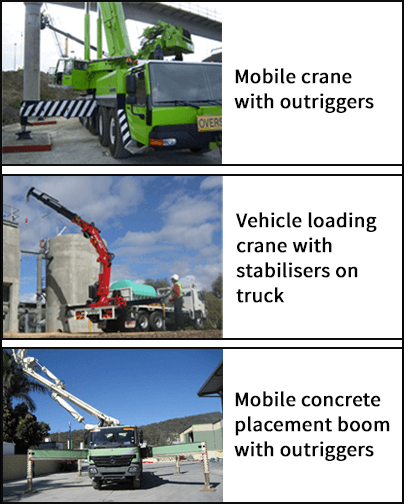-
What happened?
Three separate incidents involving unsecured stabilisers and outriggers on moving vehicles took place.
A truck fitted with a vehicle loading crane (VLC) was being driven along a road with its stabiliser extended. The stabiliser struck a parked vehicle and a worker standing behind this vehicle was crushed and killed.
A similar incident occurred when a manually operated stabiliser on a truck fitted with a VLC unintentionally extended while travelling on a public road and killed a cyclist.
An outrigger on an amusement ride trailer swung out while being driven on a public road. It hit a vehicle heading in the opposite direction, killing the driver.

-
Why did it happen?
Manually operated stabilisers rely solely on the locking mechanism to ensure they remain in the travel position. Stabilisers can extend if:
- they’re not effectively locked in the travel position
- he restraining mechanism fails
- the truck goes over a bump or around a corner
Vehicle loading cranes manufactured prior to 2004 may only have a single locking device for each stabiliser and lack secondary safety features in accordance with the latest standards and guidance.
Hydraulically operated stabilisers require restraint during road travel, although they are less likely to extend due to the resistance afforded by the hydraulic system.

-
What did they learn?
Ensure components of the stabiliser/outrigger travel restraint locking mechanism are in good condition, operating correctly, inspected and maintained in accordance with the manufacturer’s recommendations and latest standards and guidance.
Locking mechanism for manually extended vehicle loading crane (VLC) stabilisers should include two separate latching devices for each stabiliser. At least one of these should be automatically operated (e.g. a manually operated securing pin and an automatic spring latch).
Workers who drive the vehicles should be provided with appropriate instruction, training, and supervision.
Owners of vehicle loading cranes without secondary locking mechanisms on the stabilisers should consider engaging an engineer or the manufacturer to redesign and modify the locking mechanism.
VLCs manufactured prior to 2004 may only have a single locking device for each stabiliser. Cranes more than 10 years old should have the safety features updated according to the current standards and regulations (including secondary locking devices on stabilisers).
Cranes that aren’t fitted with a stabiliser warning system should be retrofitted.
The feasibility of fitting an upgraded warning and indicating system to older vehicle loading cranes should be assessed during the periodical (e.g. annual) inspection and maintenance programme.
Cranes manufactured to comply with latest standards should include an indicator to warn that the stabilisers are not locked in transport position. This system should be both visible and audible to the driver (e.g. a warning buzzer in the truck cabin).

-
Ask yourself or your crew
How can something like this happen here? What can we do to prevent it?
How do you ensure that safety guidelines are fit for purpose and adhered to?
How do you check that the locking mechanisms on your equipment are in good working order? What should you do if they aren’t?
How do we ensure that members of the public (i.e. pedestrians and cyclists) are safe during operations that require road transportation? What more can we do?

Add to homescreen
Content name
Select existing category:
Content name
New collection
Edit collection
What happened?
Three separate incidents involving unsecured stabilisers and outriggers on moving vehicles took place.
A truck fitted with a vehicle loading crane (VLC) was being driven along a road with its stabiliser extended. The stabiliser struck a parked vehicle and a worker standing behind this vehicle was crushed and killed.
A similar incident occurred when a manually operated stabiliser on a truck fitted with a VLC unintentionally extended while travelling on a public road and killed a cyclist.
An outrigger on an amusement ride trailer swung out while being driven on a public road. It hit a vehicle heading in the opposite direction, killing the driver.

Why did it happen?
Manually operated stabilisers rely solely on the locking mechanism to ensure they remain in the travel position. Stabilisers can extend if:
- they’re not effectively locked in the travel position
- he restraining mechanism fails
- the truck goes over a bump or around a corner
Vehicle loading cranes manufactured prior to 2004 may only have a single locking device for each stabiliser and lack secondary safety features in accordance with the latest standards and guidance.
Hydraulically operated stabilisers require restraint during road travel, although they are less likely to extend due to the resistance afforded by the hydraulic system.
What did they learn?
Ensure components of the stabiliser/outrigger travel restraint locking mechanism are in good condition, operating correctly, inspected and maintained in accordance with the manufacturer’s recommendations and latest standards and guidance.
Locking mechanism for manually extended vehicle loading crane (VLC) stabilisers should include two separate latching devices for each stabiliser. At least one of these should be automatically operated (e.g. a manually operated securing pin and an automatic spring latch).
Workers who drive the vehicles should be provided with appropriate instruction, training, and supervision.
Owners of vehicle loading cranes without secondary locking mechanisms on the stabilisers should consider engaging an engineer or the manufacturer to redesign and modify the locking mechanism.
VLCs manufactured prior to 2004 may only have a single locking device for each stabiliser. Cranes more than 10 years old should have the safety features updated according to the current standards and regulations (including secondary locking devices on stabilisers).
Cranes that aren’t fitted with a stabiliser warning system should be retrofitted.
The feasibility of fitting an upgraded warning and indicating system to older vehicle loading cranes should be assessed during the periodical (e.g. annual) inspection and maintenance programme.
Cranes manufactured to comply with latest standards should include an indicator to warn that the stabilisers are not locked in transport position. This system should be both visible and audible to the driver (e.g. a warning buzzer in the truck cabin).
Ask yourself or your crew
How can something like this happen here? What can we do to prevent it?
How do you ensure that safety guidelines are fit for purpose and adhered to?
How do you check that the locking mechanisms on your equipment are in good working order? What should you do if they aren’t?
How do we ensure that members of the public (i.e. pedestrians and cyclists) are safe during operations that require road transportation? What more can we do?
Multiple fatal incidents involving unsecured stabilisers and outriggers on moving vehicles took place. Ensure components of the stabiliser/outrigger travel restraint locking mechanism are in good condition, operating correctly, inspected and maintained in accordance with the manufacturer’s recommendations and latest standards and guidance.
Original content courtesy of Queensland Government















